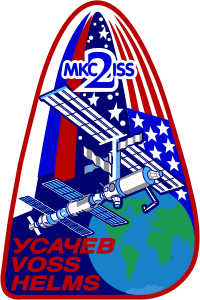Expedition 2
| Expedition 2 | |||
 | |||
| Uppdragsstatistik | |||
|---|---|---|---|
| Rymdstation: | ISS | ||
| Start: | 10 mars 2001[1] | ||
| Slut: | 20 augusti 2001[1] | ||
| Antal besättningsmedlemmar: | 3 | ||
| Rymdpromenad | |||
| Antal rymdpromenader: | 1st | ||
| Total tid: | 19 min | ||
| Transport | |||
| Uppskjutning: | med STS-102 Discovery | ||
| Uppskjutningsplats: | Kennedy Space Center[1] | ||
| Landning: | med STS-105 Discovery | ||
| Landningsplats: | Kennedy Space Center[1] | ||
| Kronologi | |||
| |||

Expedition 2 var den 2:a expeditionen till Internationella rymdstationen (ISS). Expeditionen började den 10 mars 2001 med att rymdfärjan Discovery under flygningen STS-102 återvände till jorden med Expedition 1:s besättning. Expedition avslutades den 20 augusti 2001 då rymdfärjan Discovery under flygningen STS-105 återvände till jorden med Expedition 2:s besättning.
Utbyggnad av stationen
Under Expedition 2 levererade och installerades Canadarm2 av rymdfärjan Endeavour under flygningen STS-100.
Även det amerikanska luftsluss modulen Quest, levererade och installerades under Expedition 2. Modulen levererades av rymdfärjan Atlantis under flygningen STS-104.
Besättning
| Position | (10 mars - 20 augusti 2001) |
|---|---|
| Befälhavare | Hans fjärde rymdfärd |
| Flygingenjör 1 | Hans femte rymdfärd |
| Flygingenjör 2 | Hennes femte rymdfärd |
Referenser
- ^ [a b c d] NASA's Space Station Expedition 2 Arkiverad 16 augusti 2019 hämtat från the Wayback Machine., läst 28 augusti 2016.
Externa länkar
| |||||||||||||||||||||
Media som används på denna webbplats
The first International Space Station crew patch is a simplified graphic of the station complex when fully completed. The station is seen with solar arrays turned forward. The last names of the Expedition One crew, Soyuz pilot Yuri Gidzenko, flight engineer Sergei Krikalev, and expedition commander William (Bill) Shepherd, appear under the station symbol.
Left to right :
De gauche à droite : James S. Voss, Yury V. Usachev, Susan J. Helms. Crew for the Expedition 2 to the ISS. (February 2001, NASA)
Cosmonaut Yury V. Usachev (center), Expedition Two mission commander, is flanked by the other crew members--astronauts James S. Voss and Susan J. Helms--who will join him for an extended stay aboard the International Space Station (ISS), beginning in March of this year. Usachev represents the Russian Aviation and Space Agency. The flags representing all the international partners are arrayed at bottom.ISS Expedition 2 insignia.
The International Space Station Expedition Two patch depicts the Space Station as it appears during the time the second crew will be on board. The Station flying over the Earth represents the overall reason for having a space station: to benefit the world through scientific research and international cooperation in space. The number 2 is for the second expedition and is enclosed in the Cyrillic MKS and Latin ISS which are the respective Russian and English abbreviations for the International Space Station. The United States and Russian flags show the nationalities of the crew indicating the joint nature of the program. When asked about the stars in the background, a crew spokesman said they "...represent the thousands of space workers throughout the ISS partnership who have contributed to the successful construction of our International Space Station."
ISS Expedition 3 Mission patch
It depicts the book of space history, turning from the chapter with the Russian space station Mir and the space shuttle to the next chapter, one that will be written on the blank pages of the future by space explorers working for the benefit of the entire world. Above the book is a layout of what the station will look like when completed, docked with the space shuttle. The Expedition Three crew members – astronaut Frank L. Culbertson, Jr., commander, and cosmonauts Vladimir N. Dezhurov and Mikhail Tyurin, flight engineers – had the following to say about the insignia for their scheduled mission aboard the International Space Station (ISS): “The book of space history turns from the chapter written onboard the Russian Mir Station and the U.S. Space Shuttle to the next new chapter, one that will be written on the blank pages of the future by space explorers working for the benefit of the entire world. The space walker signifies the human element of this endeavor. The star representing the members of the third expedition, and the entire multi-national Space Station building team, streaks into the dawning era of cooperative space exploration, represented by the image of the International Space Station as it nears completion.”







